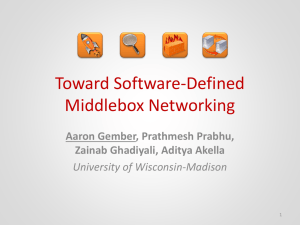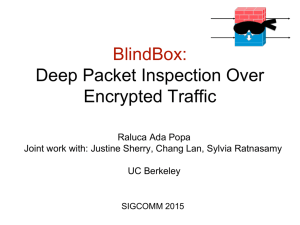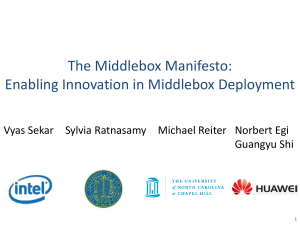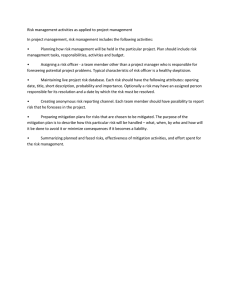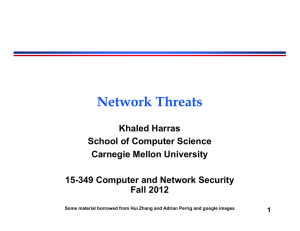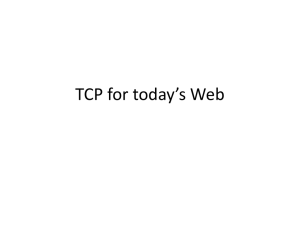dFence: Transparent Network- based Denial of Service Mitigation Ajay Mahimkar
advertisement
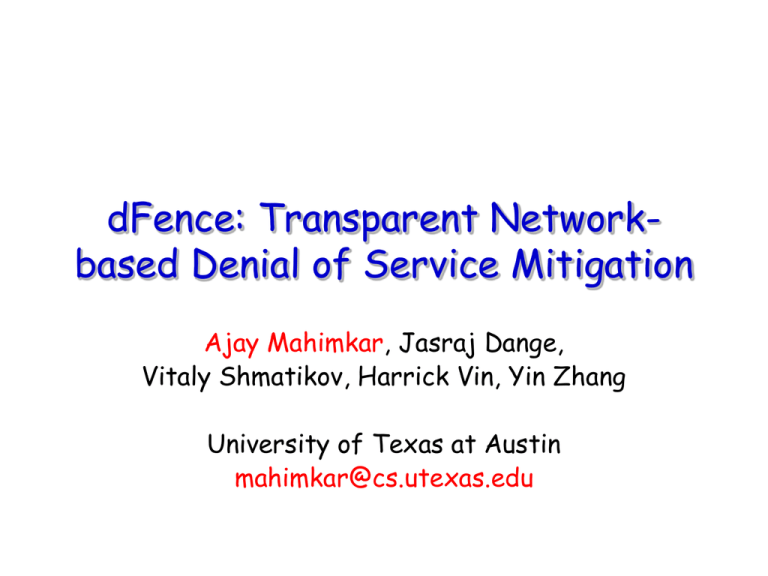
dFence: Transparent Networkbased Denial of Service Mitigation
Ajay Mahimkar, Jasraj Dange,
Vitaly Shmatikov, Harrick Vin, Yin Zhang
University of Texas at Austin
mahimkar@cs.utexas.edu
The Problem
• Denial of Service (DoS) attacks
– A significant threat to Internet reliability & availability
– Many forms – SYN flood, Data flood, NAPTHA, HTTP request
flood, Botnet
• Lots of research and commercial products
– Speak-up, SIFF, Kill-botz, TVA, Pushback, Cisco Guard, Arbor, …
• Yet, lots of attacks still out there
– Feb 6. 2007 DDoS attack on 6 of 13 root DNS servers
– Domain registrar GoDaddy.com was DDoSed (March 2007)
dFence Principles
• Transparency
– No software modifications to end-hosts or routers
• In-Network defense
– Filter attack traffic before it gets close to server
• Shared on-demand infrastructure
– Multiplex defense resources to protect multiple customers
– No performance penalty during peace time
• Stateful mitigation
– Necessary for effective defenses against a broad range of
DoS attacks
dFence Overview
Apply stateful
filtering
Other Customer
Networks
Internet Service Provider
Attack
Detected
Distributed Set of
Middleboxes
Only Good traffic
Customer Network
under protection
Challenges
• Bidirectional Traffic Interception
• Attack Mitigation Functionality
• Dynamic State Management
• Robustness to route changes, failures
and DoS attacks on middleboxes
Outline
• Bidirectional Traffic Interception
• Attack Mitigation Functionality
• Dynamic State Management
Inbound Traffic Interception
Inbound Traffic Interception
iBGP advertisements to
attract only traffic going
to the customer network
under protection
Internet Service Provider
Routing table
12.0.0.0/24 R1
10.0.0.0/24 M
R2
Other Customer
Networks
12.0.0.0/24
R1
R2
PBR rule
10.0.0.0/24 D
(on internal)
M
10.0.0.0/24
Customer Network
(D) under protection
Outbound Traffic Interception
Outbound Traffic Interception
12.0.0.0/24
Other Customer
Networks
Internet Service Provider
R1
R2
M
PBR rule
Src = 10.0.0.0/24
(on external)
M
10.0.0.0/24
Customer Network
(D) under protection
Outline
• Bidirectional Traffic Interception
• Attack Mitigation Functionality
• Dynamic State Management
Attack Mitigation at Middlebox
• Stateful policies are a good match for TCP-based
attacks
• Careful creation of minimal state for connections
Attack
Classification
Attack Examples
State Requirement
Spoofed
Spoofed SYN
Spoofed TCP data
Reflector attacks
Zero
Un-spoofed
mis-behaving
NAPTHA
Un-spoofed data flood
Temporary
Un-spoofed
well-behaving
Normal traffic
Life-time of
connection
An Example Policy
• Mitigating Spoofed Attacks
– SYN flood: exhaust server resources by
flooding it with bogus SYN requests
– Network-based SYN cookie generation
– Advantages over server-side
• Transparency
• Multiplexing
SYN Cookie [D. Bernstein]
Server
SYNC
Client
No state
maintained
Cookie is an
unforgeable token
SYNS, ACKC
(Seq# = Cookie)
ACKS (Cookie+1)
Establish
connection
if cookie is
correct
Network-based SYN Cookie
• Challenges
– How to handle mismatch in sequence number
generated by middlebox and server
– How does middlebox handle data received from
clients before its handshake with server is
complete
What does not work
• Full TCP splicing with address / port / sequence /
acknowledgement number translations
– Increases state requirement at middlebox
– Adds more processing burden
• Buffer data packets till handshake with server is
complete
– Opens door to another DoS attack
• Drop data packets till handshake with server is
complete
– Client enters TCP time-out and suffers 3 second delay
Server
Verify cookie &
establish state
Middlebox
SYNS, ACKC
(Seq# = ValueS)
ACKS (ValueS+1)
SYNC
No State Maintained
SYNS, ACKC
(Seq# = Cookie)
Window = 0
SYNC
Choke
client
Client
Sequence #
translation
ACKS (Cookie+1)
Acknowledgement
# translation
SYNS, ACKC
(Seq# = Cookie)
Re-open window
Un-choke
client
ACKS (Cookie+1)
Outline
• Bidirectional Traffic Interception
• Attack Mitigation Functionality
• Dynamic State Management
Dynamic State Management
• Middlebox introduction
– How to capture state for ongoing connections ?
– Naïve solution: terminate all ongoing connections
and let clients start anew (not transparent!!)
– Our solution
• Add grace period to transparently bootstrap state for
ongoing connection
– During bootstrap
• SYN cookies for new connection request
• Data packets (good or bad) are forwarded to the server
• State established for data packets for which ACK is seen
Dynamic State Management
• Middlebox removal
– What about active connections established via
middlebox ?
– Naïve solution: terminate all and remove middlebox
from the data path (not transparent!!)
– Our solution
• Add grace period during which the connections
established via middlebox undergo sequence and
acknowledgement numbers translation
• New connection requests are forwarded to the server (no
SYN cookies)
• No state established for new connections during the
removal phase
Experimental Setup
IXIA Packet Generator
Cisco Switch
End-hosts
IXP
• XORP for Traffic Interception
• Intel IXP Network Processor for attack mitigation policies
• IXIA for attack workload, iperf/httperf for legitimate traffic
End-to-end Throughput
Bootstrap Phase: Spoofed SYN dropped,
spoofed data forwarded
Attack Mitigation Phase
Removal Phase
Middlebox bootstrapped
Attack stopped
Attack started
Middlebox removed
Throughput drops
Middlebox introduced
Conclusion
• dFence DoS mitigation system
–
–
–
–
Transparent solution
In-network defense
Shared on-demand infrastructure
Stateful mitigation
• Can be viewed as providing group insurance
service
• General platform to deploy other network
security services such as malware filtering
Thank You !
Backup Slides
Flow Pinning
• Why Pinning ?
– Ensure both directions of flow go through the
same middlebox
– Ensure that the same middlebox handles the flow
even when there are route changes / failures
• Pin the flow to a home middlebox
– Home middlebox = hash1 (src IP, src port) EXOR
hash2 (dest IP, dest port)
– Symmetric
Bootstrap Interval Tb
Too high
• Severe damage during bootstrap phase
Too low
• Ongoing connections may get terminated
Trace analysis
shows that majority
of connections has
packet IATs of the
order a few seconds
XORP BGP Policy
policy-statement next-hop-selection {
term 1 {
to { network4: 10.0.0.0/24 }
then { localpref: 300 }
}
}
…
protocols {
bgp {
…
import “next-hop-selection”
export “next-hop-selection”
}
}
Middlebox Attacks & Defenses
• Exhausting the connection state
– Defense: Limit number of connections from any single host
• Middlebox only maintains state for un-spoofed well-behaved
sources
• Adaptive traffic variation attack
– ON/OFF attack pattern
– Defense: Avoid rapid introduction & removal of middleboxes
• Randomize the removal phase time interval
• Werewolf attack
– Behave legitimate at first, get established in middlebox
state and then bombard with attack traffic
– Defense: Periodic measurement of traffic sending rates &
source prefix white-listing
End-to-end latency
